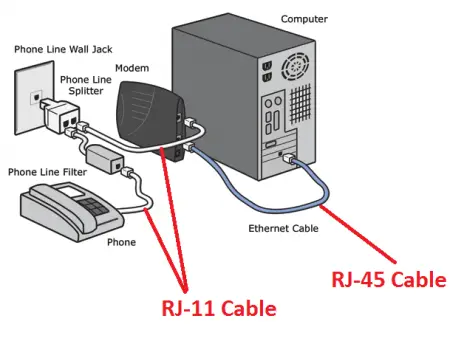The two most important components in a basic computer network are a modem and a router. Despite being present in the majority of homes in the US, it’s not uncommon for people to get confused about these computer peripherals. This article explains how a modem and a router are different in many aspects.
Summary Table
| Modem | Router |
| Establishes internet connection by receiving and transmitting data traveling over telephone wires | Distributes data from the modem to connected devices. |
| Usually supports wired connections only | Can support various types of wireless devices |
| Can work without a router | Cannot function if disconnected from the modem |
Descriptions

The word modem is a short term for modulator and demodulator and is a computer hardware used to establish communication between distant computers. Modems allow the exchange of data between interconnected computers. For residential users, a modem provides cable or DSL internet service. Cable modems use coaxial cables running to a cable port on the wall. DSL modems are connected to the phone socket on the wall via an RJ-11 jack, also called a telephone connector.
Modulation occurs when digital data coming from a computer is changed into analog data before being transported over telephone lines. Demodulation happens when analog data from the phone lines are transformed into digital data that computers can read.
There are different kinds of modems and they are classified based on a few factors. One classification of modems is how they connect to the internet. Dial-up modems of the 20th century were the forerunners of DSL and cable TV modems which are widely used today. Modems can also be classified by the amount of data they can move in a given time, usually measured in bits per second or bps.
Dial-up modems operating at maximum speeds of 56,000 kilobits per second were considered fast in the year 2000. The decline of these 56K modems in 2006 paved the way for DSL and cable modems. These modems are capable of processing data ten times faster than dial-up.

A router is a piece of computer hardware equipped with software that works to transfer data between computers connected to a network. Its primary task is to direct and make sure traffic between these networked devices gets where they are supposed to go. Routers accomplish this by selecting the quickest path possible by utilizing a complex system of rules called Routing Protocols. Routers are characterized by one or more processors, a custom operating system, NVRAM, RAM, flash memory, and two or more network interfaces. Routers come in a wide range of sizes; from palm-sized routers to ones too large for a single person to lift.
Residential users usually have a router installed for their wireless devices (e.g. laptop, tablets, smartphones) to connect to when going online. Routers usually come with ethernet ports to accommodate wired connections as well. Although the majority of home internet connections are already using modem/router combos, routers were initially used to extend network connectivity at home by connecting it to a modem via a dedicated ethernet port. Thus, if the router is not connected to a modem, devices connected to the router won’t be able to go online either.
Modem vs Router
So what’s the difference between a modem and a router?
A modem is a computer peripheral that allows two or more distant computers to connect to each other. It establishes internet connection as it decodes and encodes signals travelling over phone lines. A router, on the other hand, distributes data to devices connected to it as well as passing signals coming from the devices to the modem. In addition, a modem is essential to get connected to the internet, while a standalone router needs a modem to be able to send and receive data.
Nowadays, most people use a modem/router hybrid setup. However, many residential users still make use of modem/router hybrid + router, or modem + router to extend the reach of their internet connection and allow more of their devices to connect to the internet.
Video
Here’s a useful YouTube video explaining the difference between modems and routers.





